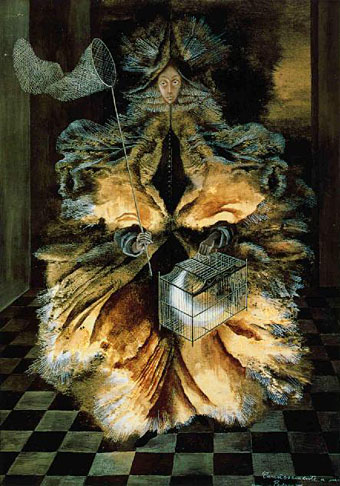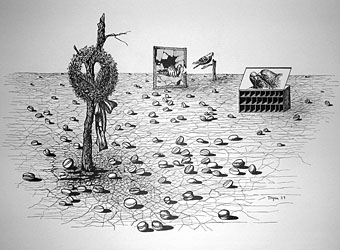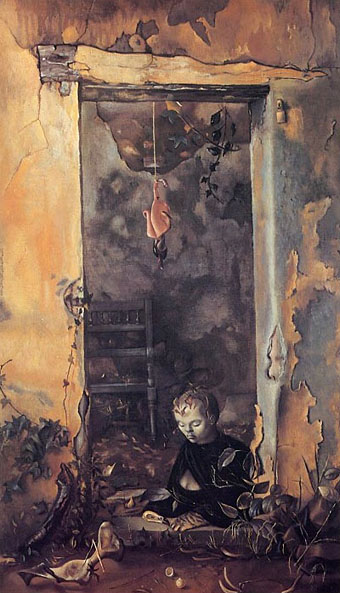Was the Surrealist movement the first art grouping to give female creators more of an equivalent status to their male counterparts? The recent posting about Leonora Carrington had me considering this question again (yes, this is what taxes my brain while it’s awake). The answer isn’t so easy to find since women artists had been emerging gradually since the late 19th century, from Berthe Morisot onwards. Women certainly played a greater role in the development of Surrealism than they were allowed to do in earlier art movements, and their work is continually featured in histories of the period. The men were still accorded all the glory, of course, and many of the women were only given an opportunity by virtue of being wives or lovers of the male artists, but they still managed to map out their own imaginative territory. The following are some of the more notable examples.

Birthday by Dorothea Tanning (b.1910).
My personal favourite, a very accomplished painter who married Max Ernst.

Cazadora de Astros by Remedios Varo (1908–1963).
Mexican artist and a friend of Leonora Carrington.

I Saw Three Cities by Kay Sage (1898–1961).
The wife of Yves Tanguy.

The Shooting Gallery by Toyen (Marie Cermínová) (1902–1980).
A Czech artist who rejected her given name. Poorly represented on the web.

Illustration (title unknown) by Valentine Hugo (1887–1968).
Another painter and illustrator with few examples on websites.

Little Hermit Sphinx by Leonor Fini (1908–1996).
Not always classed among the Surrealists but all her early paintings show a Surrealist influence.
Tendreams.org has a great selection of galleries for Dorothea Tanning, Leonora Carrington, Remedios Varo and Leonor Fini. A shame that their way of presenting the pictures has to be so annoying. Leonor Fini also has an official site.
Elsewhere on { feuilleton }
• The fantastic art archive
Previously on { feuilleton }
• Leonora Carrington

My personnal favourite is Leonor Fini (I grew up amongst her paintings)…
I have to agree with Nathalie. Fini’s is great, I think I am going to check her site right now.
To answer your question (I just came across your post to which I am replying… ), the Surrealists didn’t really “give female creators more of an equivalent status”. Andre Breton, who wote the Surrealist Manifestos was generally not a supporter of women artists. The female surrealists mostly developed on thier own, and in their own style/subject matter, and as you say, orbited the “group” through their husbands/ lovers, etc.
In art history, the only “art grouping” that really seems to have had equality for women was the Russian Avant Garde movement of the early 1900’s. (Popova, Stepanova,etc.). This mostly seems to be because the general idelogy of this movement was equality for all. And, it seems, they actually practiced this. I say “seems” because I have no first hand accounts from women, so with out that there is no way to truly know if women felt they were “equal”.
Nice choices of art, by the way.
Thanks Daniella. Yes, that makes sense, the Surrealists were fairly open about sexuality but–like most men of their generation, I suppose–their attitude to women reflected the order they were otherwise stood against. The same thing happened among radical groups in the Sixties, as the emerging feminists frequently pointed out; men who were politically avant garde still treated women the way any member of the establishment would.
The little I know about early Soviet art would bear out a picture of parity between the sexes, at least for a while. I posted earlier about Vera Mukhina’s huge monument:
http://www.johncoulthart.com/feuilleton/2007/02/21/dead-monuments/
The example of that shows that the authorities of the time had no qualms giving an important public project to a woman.
Hello,
I like picture for Toyen.
Do you have this pleas this artist?
Do you have pleas post my informacion I have very much interest.
Thenk you Vankova
I obviosly am late here. I have no comment about woman in the surrealist movement, but I do have to say as much as I appreciate Fini, Varos is my true avorite regardless of genre.